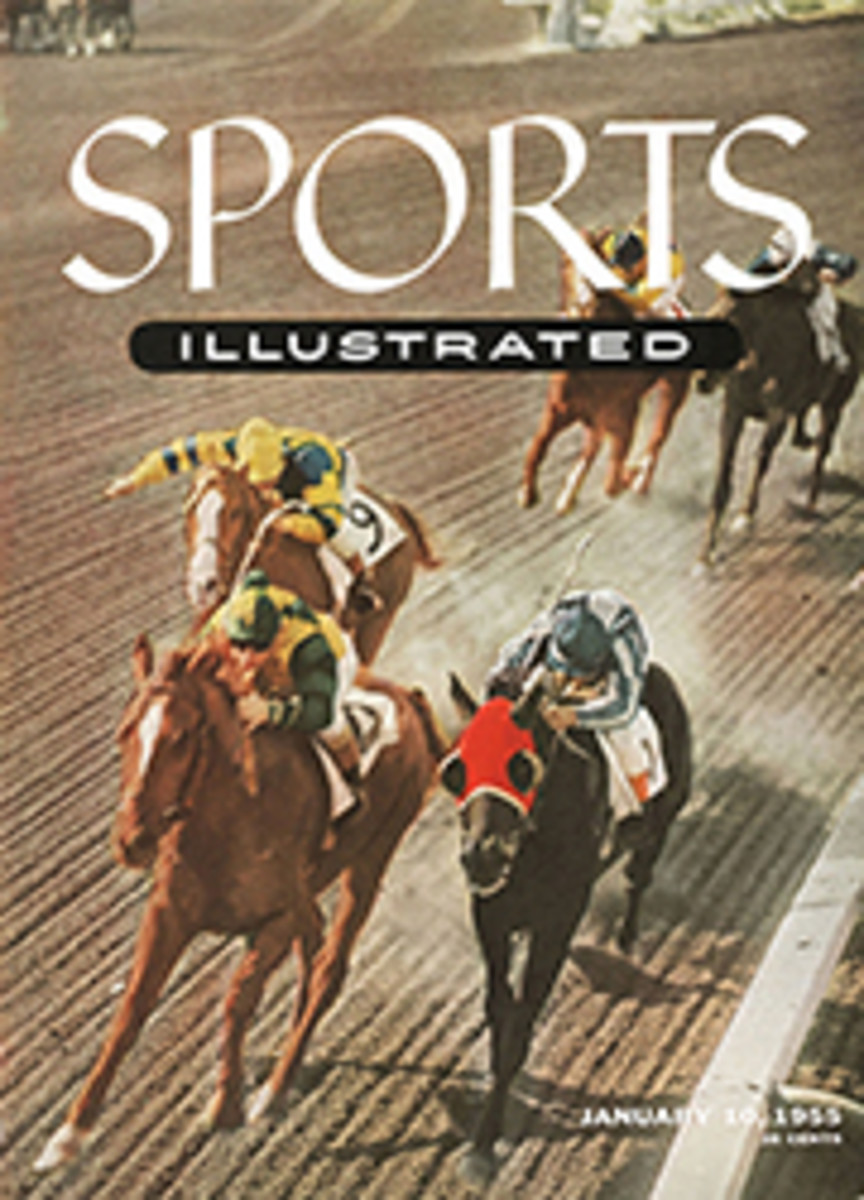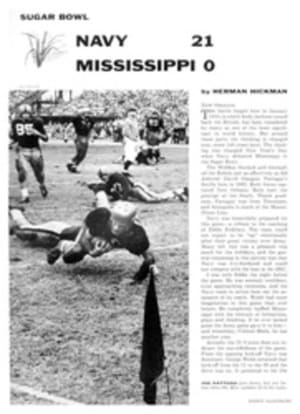
STRUB'S SANTA ANITA
At Belmont Park last week winter wind rattled down the backstretch and the far turn was a furrow of cold mud. At Jamaica the paddock stood silent and empty. At other tracks in other places, tufts of ghostly snow or the fierce howlings of blue northers spun across finish lines.
But out in Arcadia, Calif. a warm sun dappled down on a million pansy blossoms and a crowd of 30,000 felt a pleasurable shiver of anticipation as a gaudy gentleman in the scarlet greatcoat and furry top hat of a Dickensian outrider strode to the center of the harrowed track and raised his long-stemmed bugle to his lips. It was the call to the colors for the start of the 18th annual Santa Anita Park racing season. A moment later a dozen sleek, shiny thoroughbreds, their jockeys' silks glistening in the sunlight, burst onto the track and minced toward the starting line. To the racegoer, it was the prettiest sight in the world.
Even by California's standards, Santa Anita Park is an extravagance of beauty. It boasts beyond question the finest backdrop in American racing—the majestic Sierra Madre mountain range which looks over the backstretch, sometimes escarped in snow. Lordly Washington palms, Carolina cherry hedges, rustling pepper trees and hillocks full of blooming calendulas dot an infield which boasts the greenest grass in Southern California thanks to a heavy planting of fescue. Even the walking paths are covered with a rust-colored red shale from which the oil has been expensively extracted. At Santa Anita, even nature is often not quite good enough.
Santa Anita Park is as successful as it is beautiful. Twenty years ago when Santa Anita first opened its doors (on Christmas Day in 1934) after Movie Producer Hal Roach and a bunch of his polo-playing pals had barely rounded up the money ($1 million), there were more skeptics than believers. A local bank lent the track enough money to cover wagers but it wanted the money back by nightfall and sent along a crew of armed guards to make sure. "Hell, if you build a track in downtown L.A., these hicks'll step around it," the promoters were warned.
HANDLE: $2 MILLION A DAY
What happened, of course, was that the hicks stepped some 14 miles to the east to get at the track and in such numbers as racing had never seen before. In one single season (1945-'46), a daily average of $2,557,937 was bet. Daily attendance (1946-'47) averaged an incredible 35,247. One day (Handicap Day in 1947), so many people showed up (85,500) that a crisis was created (the plumbing caved in under the strain) and the card almost had to be canceled. Last year 27,166 persons a day showed up and bet a total of $96,899,527, almost $2 million a day.
The man responsible for this fairyland success of the track is a tall, rheumy-eyed, former dentist from San Francisco named Charles H. Strub. The 70-year-old Strub, a onetime minor league second baseman, is a rare promoter who combines the sentimentality of the bleacher fan with the hard-headedness of a coin-biter in a counting house. If he has spent millions in institutional advertising to convince the public Santa Anita is a public trust whose revenue does much to support agricultural colleges and county fairs, he also spends millions at the legitimate improvement of the breed. Two years ago, for example, he installed a picturesque grass course when there was scarcely any public clamor for it.
In the days when Strub had spent the entire million dollars raised by stock issue to buy the 401 acres of Santa Anita Rancho and was in hock another $300,000 to build his mezzanine, he posted the first $400,000 stake. It was like pulling all the blue chips out of the poker pot to bet on the last card. But it paid off.
In Southern California the Sport of Kings has become the sport of orange pickers and not even the clubhouse is the private preserve of the mink stole and jeweled lorgnette.
FLAIR FOR ELEGANCE SHOWN
But Strub can point to a board of directors that includes a Firestone and a Doheny and a dozen others whose breeding is of Jockey Club caliber. Besides, the indiscriminate offering of hundred-grand stakes has resulted in the finest horses in America, North or South, appearing at Santa Anita. The very first year, Twenty Grand, Equipoise, Top Row and Time Supply made the trek west for the Handicap.
The greatest horse to run at Santa Anita was C.S. Howard's Seabiscuit, which finished a heartbreaking second two years in a row in the big' Cap before finally winning it in one of the most emotional afternoons (March 2, 1940) racing has ever seen. The greatest horse race ever run anywhere (in the opinion of horsemen like Sunny Jim Fitzsimmons) was run at Santa Anita on closing day in 1950. Calumet's Citation and C.S. Howard's Noor battled head-and-head over the last three-quarters of the mile-and-three-quarter San Juan Capistrano Handicap to finish a nose apart in the world record time of 2:52 4/5. The photo said Noor just won it.
Each year, something new is added to Santa Anita. This year it was a special $100,000 addition to the training track requiring the moving of 120,000 cubic yards of dirt, and a press box improvement including soundproofed TV, radio and newsreel rooms.
Catering at Santa Anita is high art. The pedigreed hot dogs have a special sheepskin casing. The beef is Eastern steer, and $1 a sandwich. The half-buck hamburgers are worth it, claims the caterer, as they are virtually ground-up best-in-shows (stock shows, that is).
The track's caterer has his own racing silks and enjoys the same social status as the Whitneys, the Vanderbilts, Markeys and King Ranchers whose colors fly alongside his. The Strub flair for elegance is everywhere apparent from the brown-and-black clad bellhops to the gold-keyed wine clerk in the deep-pile carpeted Turf Club, the elite membership group of the track. Stewards on the track scorn the utilitarian station wagon for transportation and are paced to their observation posts by spanking teams drawing red-and-black, leather-upholstered phaetons piloted by liveried coachmen.
Amid all this courtly elegance, the rich and unwashed swizzle 15,000 bottles of beer on a hot day. On a cold day they drink 15,000 cups of coffee. On any day they load up on 10,000 Scotch-and-sodas. The big, captive, mobile audience (a race crowd is never still between races) is trapped into gorging itself by 25 food bars, 20 beverage bars, the plush reserved tables of the Turf Club and clubhouse, innumerable coffee shops and the massive paddock room under the grandstand, a cafeteria-style eatery which can serve 5,000 people a day and which has real plants on its support pillars because Strub couldn't stand the artificial kind. They get too dusty.
FUNDAMENTALIST MAKES HIS BET
Nothing is too good for the man at the $2 window at Santa Anita. If he wants to, he can bring a box lunch and his kids and let them romp around the lush, pansy-bedecked infield. On closing day, he can pull the pansies up by the roots and take them home.
But surrounded by this wholesome opulence, he is often oblivious to it. On opening day last week, a typical customer was Textile Salesman D. Edward Laurent. A racing fundamentalist, Laurent ignored the Steele pansies, Washington palms, even the awesome Sierra Madres and went right to the heart of the matter: the Daily Racing Form.
He decided on Tee Man at 30-1. Tee Man was as good as Laurent's faith. Off dead last he found a nice hole turning into the stretch and finished an impressive, driving second (to Jockey Willie Shoemaker and Mr. Bazooka). Santa Anita's meet was well under way, Horseplayer Laurent was $23.90 to the good and all in all it looked like a great year for the improvement of the breed.
PHOTO
PHOTO
CHARLES H. STRUB looks out over the Santa Anita track, which nestles against the magnificent backdrop of the Sierra Madre mountains and draws top horses, big crowds.
THREE PHOTOS
OPENINGS at Santa Anita are super-saturated with society, sports and movie leaders like Louis B. Mayer (hatted, at left) shaking hands with Beverly Hills sportsman Neil McCarthy, Betty Grable (center) and Mr. and Mrs. Reese Taylor (at right).

